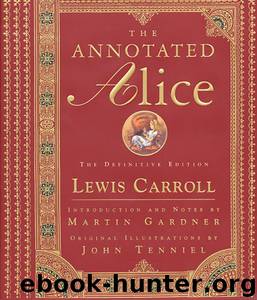The Annotated Alice: The Definitive Edition (The Annotated Books) by Carroll Lewis

Author:Carroll, Lewis [Carroll, Lewis]
Language: eng
Format: epub, mobi
Publisher: W. W. Norton & Company
Published: 1999-11-17T00:00:00+00:00
Carroll then proceeds to interpret the words as follows:
BRYLLYG (derived from the verb to BRYL or BROIL), “the time of broiling dinner, i.e. the close of the afternoon.”
SLYTHY (compounded of SLIMY and LITHE). “Smooth and active.”
TOVE. A species of Badger. They had smooth white hair, long hind legs, and short horns like a stag; lived chiefly on cheese.
GYRE, verb (derived from GYAOUR or GIAOUR, “a dog”). To scratch like a dog.
GYMBLE (whence GIMBLET). “To screw out holes in anything.”
WABE (derived from the verb to SWAB or SOAK). “The side of a hill” (from its being soaked by the rain).
MIMSY (whence MIMSERABLE and MISERABLE). “Unhappy.”
BOROGOVE. An extinct kind of Parrot. They had no wings, beaks turned up, and made their nests under sundials: lived on veal.
MOME (hence SOLEMOME, SOLEMONE, and SOLEMN). “Grave.”
RATH. A species of land turtle. Head erect: mouth like a shark: forelegs curved out so that the animal walked on its knees: smooth green body: lived on swallows and oysters.
OUTGRABE, past tense of the verb to OUTGRIBE. (It is connected with old verb to GRIKE, or SHRIKE, from which are derived “shriek” and “creak”). “Squeaked.”
Hence the literal English of the passage is: “It was evening, and the smooth active badgers were scratching and boring holes in the hill-side; all unhappy were the parrots; and the grave turtles squeaked out.”
There were probably sundials on the top of the hill, and the “borogoves” were afraid that their nests would be undermined. The hill was probably full of the nests of “raths”, which ran out, squeaking with fear, on hearing the “toves” scratching outside. This is an obscure, but yet deeply-affecting, relic of ancient Poetry.
It is interesting to compare these explanations with those given by Humpty Dumpty in Chapter 6.
Few would dispute the fact that “Jabberwocky” is the greatest of all nonsense poems in English. It was so well known to English schoolboys in the late nineteenth century that five of its nonsense words appear casually in the conversation of students in Rudyard Kipling’s Stalky & Co. Alice herself, in the paragraph following the poem, puts her finger on the secret of the poem’s charm: “. . . it seems to fill my head with ideas—only I don’t know exactly what they are.” Although the strange words have no precise meaning, they chime with subtle overtones.
There is an obvious similarity between nonsense verse of this sort and an abstract painting. The realistic artist is forced to copy nature, imposing on the copy as much as he can in the way of pleasing forms and colors; but the abstract artist is free to romp with the paint as much as he pleases. In similar fashion the nonsense poet does not have to search for ingenious ways of combining pattern and sense; he simply adopts a policy that is the opposite of the advice given by the Duchess in the previous book (see Chapter 9, Note 6)—he takes care of the sounds and allows the sense to take care of itself. The words he
Download
The Annotated Alice: The Definitive Edition (The Annotated Books) by Carroll Lewis.mobi
This site does not store any files on its server. We only index and link to content provided by other sites. Please contact the content providers to delete copyright contents if any and email us, we'll remove relevant links or contents immediately.
| Booksellers & Bookselling | General |
| History of Books |
4 3 2 1: A Novel by Paul Auster(11739)
The handmaid's tale by Margaret Atwood(7406)
Giovanni's Room by James Baldwin(6745)
Asking the Right Questions: A Guide to Critical Thinking by M. Neil Browne & Stuart M. Keeley(5317)
Big Magic: Creative Living Beyond Fear by Elizabeth Gilbert(5299)
Ego Is the Enemy by Ryan Holiday(4885)
On Writing A Memoir of the Craft by Stephen King(4635)
The Body: A Guide for Occupants by Bill Bryson(4534)
Ken Follett - World without end by Ken Follett(4409)
Bluets by Maggie Nelson(4224)
Adulting by Kelly Williams Brown(4197)
Eat That Frog! by Brian Tracy(4100)
Guilty Pleasures by Laurell K Hamilton(4085)
White Noise - A Novel by Don DeLillo(3805)
The Poetry of Pablo Neruda by Pablo Neruda(3779)
Fingerprints of the Gods by Graham Hancock(3706)
Alive: The Story of the Andes Survivors by Piers Paul Read(3703)
The Book of Joy by Dalai Lama(3648)
The Bookshop by Penelope Fitzgerald(3593)
